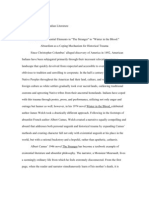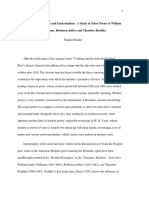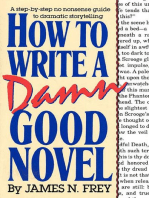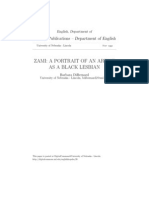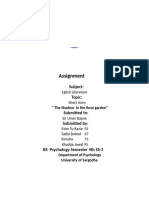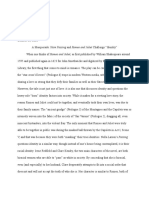Humour and Identity
Humour and Identity
Uploaded by
Lyann MartinezCopyright:
Available Formats
Humour and Identity
Humour and Identity
Uploaded by
Lyann MartinezCopyright
Available Formats
Share this document
Did you find this document useful?
Is this content inappropriate?
Copyright:
Available Formats
Humour and Identity
Humour and Identity
Uploaded by
Lyann MartinezCopyright:
Available Formats
125
STEPHAN KARSCHAY AND JOANNA ROSTEK
"Man haf fe do wha man haf fe do:" Humour and Identity
(Re)Formation in Bernardine Evaristo's Mr Loverman
On reading the blurb of Mr Loverman (2013), one is led to assume that Bernadine
Evaristo's seventh novel has a particular literary staple in its sights: the eternal con-
flict between the needs and desires of an individual on the one hand and the normative
behaviour expected and often prescribed by society on the other. Mr Loverman exam-
ines why individuals end up opting for imperfect compromises and the price they pay
for the choices they make. The novel demonstrates how we fashion ourselves and are
perceived by others through a range of markers that dissect identity into separate
categories, such as class, race, age, gender, sexual orientation, or family status and
how each of these categories triggers distinct social expectations. Problems arise
when one's individual needs begin to jar with cultural norms, and when the expecta-
tions resulting from one particular marker of identity (for instance race) cannot be
reconciled with those stemming from another (for instance sex).
Mr Loverman's flamboyant protagonist, Barrington Jedediah Walker, is the bearer
of a whole set of culturally charged identity markers: he is an affluent, married septu-
agenarian black man of Caribbean descent who is also a closeted homosexual. Up to
his present age of 74, he could not allow himself to be all of these things openly and
simultaneously. Instead, Barry had to give priority to one part of his personality to the
detriment of another: in order to do justice to a particular concept of masculinity – one
that in turn was shaped by his Caribbean provenance – Barry has until now concealed
his homosexuality and his decades-spanning love relationship with fellow Antiguan
Morris De la Roux. In what Kate Colquhoun has termed a "tale of the complicated
untruths that can fester at the core of a tight community, the bluster that masks fear
and, ironically, the importance of restraint" (2013), Mr Loverman shows the reasons
for and the consequences of Barry's dissimulation, depicting the scars it has left on
him, his lover Morris, his two daughters, and – above all – his wife Carmel. It traces
the protagonist's gradual acceptance of an alternative but more truthful identity that is
grounded in his open homosexuality and that supersedes his more conventional posi-
tion as the patriarchal head of an extended family of immigrants. Barry can only over-
come his late-life crisis and envision a golden old age once he manages to
acknowledge the complexities of his own identity and to harmonize what at the be-
ginning of the novel seem to him to be mutually exclusive and therefore 'unliveable'
dimensions of his character:
They think they know me.
Husband of Carmel.
Father of Donna and Maxine.
Grandfather to Daniel.
Retired engine-fitter.
Man of property.
Man of style.
Buggerer of men… How I go live with that? (Evaristo 2013, 134)
Anglistik: International Journal of English Studies 27.1 (March 2016): 125-136.
Anglistik, Volume 27 (2016), Issue 1
© 2016 Universitätsverlag WINTER GmbH Heidelberg
Powered by TCPDF (www.tcpdf.org)
126 STEPHAN KARSCHAY AND JOANNA ROSTEK
While the difficulty of balancing individual and social needs may be a universal
concern of literature, what makes Evaristo's novel special for our reading is that Barry
unwittingly holds the answer to his above question – and thus the key to his self-made
closet – in the method of his trademark sense of humour: "I am the Great Mood Levi-
tator. I am the Human Valium" (Evaristo 2013, 4), is one of Barry's earliest self-
characterizations. Through his sprightly first-person narration that dominates the
novel (a more despondent foil is provided by the less frequent interior monologues of
Barry's wife), Evaristo often turns a comic eye on the painful issues of deception, self-
for personal use only / no unauthorized distribution
denial, and regret, without ridiculing the serious topics at the heart of her text. Even
though Mr Loverman is a novel about lies, repression, and aging, critics have charac-
terized it as "funny" (Thomson 2013), "sometimes hilarious" (Colquhoun 2013), and
in parts "comical" (Canning 2013). It is the aim of our article to analyze the function
of Barry's humour on his troubled journey to self-knowledge. More specifically, we
will investigate to what extent Mr Loverman's protagonist uses the comic as a strategy
to cope with the discursive categories of race, gender, sexuality, and age in the pro-
Winter Journals
cess of his identity (re)formation.
Before embarking on a close reading of the novel, it is worth asking why humour
might be a particularly useful tool for exploring the serious vicissitudes of age, gen-
der, sex, and race as well as the overarching issue of identity formation. As a starting
point, it is helpful to quote Gaby Pailer's observation that there is "a remarkable inter-
section between gender theories and theories of laughter, the comic, and comedy: in
both areas the question of physicality for shaping or expressing identity is a major
issue, and in both fields critics claim the subversive potential of bodily acts towards a
cultural norm" (Pailer 2009, 7).
Manfred Pfister, commenting on the connection between laughter and sexuality,
likewise stresses that "[t]hey are both closely linked to our corporeal nature" (2002,
vi) and also notes:
In both cases, an instinctual drive or corporeal reaction forms the anthropological basis
that is given widely divergent socially acceptable expression [sic] and functions in the
Powered by TCPDF (www.tcpdf.org)
various cultures; and in both cases, the anthropological drive – sexual desire or the vis
comica – constantly threatens to subvert the social bounds set up to contain it. In the
case of both sex and laughter, what emerges is that both their histories are mainly histo-
ries of attempts to limit, control and civilise them, be it through negative injunctions
and taboos or through setting up particular forms of gender relations […] or particular
forms of laughter […] as positive models to be aspired to. (v-vi)
Pursuing this line of thought further, one may note that besides gender and sexual-
ity, race (by way of skin colour) and age (by way of changes in the body's cellular
structure) similarly involve a manifestly corporeal element, which, however, is cultur-
ally overdetermined. What humour thus shares with categories such as age, gender,
sex, and race, is a dual nature, i.e. a material, bodily dimension on the one hand that
evolves in and interacts with a non-material, cultural realm on the other. The tensions
adherent to this dualism lie at the core of Mr Loverman, which portrays how cultural
norms have shaped the protagonist's aging, black, male body, and his "full-blooded,
hot-blooded, pumping-rumping, throbbing organ of an uncontainable, unrestrainable,
undetainable man-loving heart" (Evaristo 2013, 17). For Barry, humour is a strategy
that imitates, masks, and helps to bridge the tensions between 'nature' and 'culture' that
act upon him.
Laughter can be variously untamed, uncontrollable, and subversive, or regiment-
ed, disciplinary, and order-affirming. Pfister notes, moreover, that it "is always caught
Anglistik, Volume 27 (2016), Issue 1
© 2016 Universitätsverlag WINTER GmbH Heidelberg
Powered by TCPDF (www.tcpdf.org)
HUMOUR AND IDENTITY (RE)FORMATION IN BERNARDINE EVARISTO'S MR LOVERMAN 127
up in the distinctions between centre and margins every society employs to establish
and stabilise its identity" (2002, vi). While in some cases, laughter emerges as a defi-
ant strategy of excluded outsiders, in other contexts, as Andreas Böhn points out, the
comic "does not necessarily tend to overcome traditional oppositions and ideological
boundaries" (2009, 62). Andy Medhurst points to yet another possible effect of hu-
mour in the process of identity formation: "It is exactly because identities are so dis-
puted, so slippery, so rocky and so anxious that the celebration of belonging offered
by comedy is all the more welcome" (2007, 19). Humour is thus, like identity itself, a
complex, multi-layered phenomenon and invariably serves different, at times conflict-
ing, ends. It is therefore fitting that Evaristo's protagonist uses his comic versatility to
defend and to attack; to exclude and to include; to ward off and to accept; to alleviate
and to circumvent painful introspection.
From Barrysexual to Homosexual: Humour and the Investigation of Race, Gen-
der, and Sexuality
Barry is a uniquely garrulous narrator with an opinion on almost everything ("Sociol-
ogy, Psychology, Archaeology, Oloyology – you name it. English Literature, French
Language, naturellement." [Evaristo 2013, 8]), and thus much of the comedy in Mr
Loverman is of a rhetorical, rather than a theatrical, nature. Stupendously versed in
Shakespeare's oeuvre, Barry fashions himself as an armchair poet worthy of the high-
est accolades: "Derek Walcott? You listening over there in St Lucia? Mi no care if
you did get the Nobel Prize for poetry, you better watch out, because Barrington
Walker's goin' steal the linguistic march on you, fella" (11). A part of Barry's humour,
then, is notable for its sheer irreverence and its creative amalgamation of apparently
incompatible rhetorical compounds. It can be related to the incongruity theory of
humour (cf. Morreall 1983, 15) whose essence is captured in a comment by the 17th-
century writer and natural philosopher Blaise Pascal: "Nothing produces laughter
more than a surprising disproportion between that which one expects and that which
one sees" (Pascal qtd. in Morreall 1983, 130). Barry's ability to create amusing lin-
guistic inconsistencies is directly linked to his Caribbean heritage. An autodidact of
many parts, he can "speak the Queen's as well as any Big Englander" (Evaristo 2013,
6), but will, on occasion, "mash up the h-english linguish whenever we feel like it,
drop our prepositions with our panties, piss in the pot of correct syntax and spelling,
and mangle our grammar at random" (6-7). Inventively mingling standard speech
with Jamaican patois, Mr Loverman easefully moves between registers whose combi-
nation creates humour out of incongruence. Pondering the troubled relationship with
his daughters, for instance, Barry invents mock-Shakespearean words, which he then
arranges in a figura etymologica to enhance the hyperbole that is so characteristic of
his speech in general: "Donna, in particular, stored up all her beshittery for her father
– who was beshat upon from a great height" (134).
Just like Shakespeare's own examples of the genre, Mr Loverman is a comedy
which ends with the reconciliation of two lovers (Barry and Morris), the symbolic
expurgation of a blocking figure (Barry's wife Carmel) and the restoration of a certain
order out of chaos. Yet Barry's story at times veers dangerously close to a tragic out-
come, since his particular quest for happiness involves the difficult examination of
race, gender, and sexuality as ambiguous and often contradictory fields of identity
formation. In a reading of contemporary Caribbean fiction by Michele Cliff and H.
Nigel Thomas, Timothy Chin has emphasized the importance of such an examination
for a progressive development within and between individuals of different cultures:
Anglistik, Volume 27 (2016), Issue 1
© 2016 Universitätsverlag WINTER GmbH Heidelberg
Powered by TCPDF (www.tcpdf.org)
128 STEPHAN KARSCHAY AND JOANNA ROSTEK
"These sites of ambiguity and contradiction – which often reflect how 'differences' are
actually lived and negotiated – are, paradoxically perhaps, the ones that can potential-
ly enable new forms of social and cultural relations" (1997, 139). Barry himself has
been witness to such newly formed social and cultural relations in his immigrant
experience of a more tolerant and less racist British society. On remembering how the
managing director of Ford Motors ("Mr Lardy Comb-Over") patronized him at his
retirement party by explaining the word raconteur, in the assumption his former em-
ployee might not understand "words of five syllables or ones that was a bit Frenchi-
fied" (Evaristo 2013, 7), Barry's temper briefly flares up again, yet he happily admits
that racist taunts are a thing from the past: "Never no mind. Those days long gone.
I've not been called no names by nobody except the wife for at least twenty years" (6).
Of humble origins in Antigua, Barry has managed to rise in the ranks of British
post-war society to a position of upper-middle-class affluence. The driving force
behind this story of a successful acculturation is, however, a deep-seated fear of cul-
tural ostracism as Barry's confessional statement, "I don't like being an outsider"
(159), makes clear. Yet while this anxiety has proved to be conducive to Barry's eco-
nomic success and the confident assertion of his Black Britishness, it also prevents
him from aligning his gender identity with his homosexuality. More specifically,
Barry finds himself in a critical conundrum (in both senses of the word 'critical') that
Dwight McBride has identified as a major stumbling block in the study of culture:
When we give "race," with its retinue of historical and discursive investments, primacy
over other signifiers of difference, the result is a network of critical blindnesses that
prevents us from perceiving the ways in which the conventions of race discourse get
naturalized and normativized. These conventions often include […] the denigration of
homosexuality and the accompanying peripheralization of women. Underlying much of
race discourse, then, is always the implication that all "real" black subjects are male and
heterosexual. (1999, 263)
In a similar way, by having predominantly defined himself in terms of race – as a
London-based black Briton of Caribbean descent – Barry impedes a self-investigation
of his troubled gender identity. Despite his assertion that "I am an anti-discriminatory
person" (Evaristo 2013, 137), he conforms to the normative standards of a patriarchal
gender ideology that is both openly misogynistic and homophobic. Furthermore, it is
telling that Barry's liberal claim is only part of his interior monologue and does by no
means tally with his explicitly voiced statements, thus making again visible the lie he
lives.
In light of the unresolved conflict between his 'racial' and his gender identities,
Barry's witty statements can be partly explained by the relief theory of laughter. Orig-
inating in the works of the third Earl of Shaftesbury in the 18th century, the relief
theory was prominently elaborated by Herbert Spencer in the 19th century and trans-
posed to the field of psychoanalysis by Sigmund Freud in the early 20th. Its basic idea
is that humour serves the physiological function of releasing a surplus of nervous
energy, in an analogous way to a steam cooker, which will release extra pressure
through a relief valve (cf. Morreal 2009, 16). Arguably, Barry's humour can be read
as such a coping strategy which allows him to externalize his inner tension. This ex-
plains why many of his humorous remarks have a derisory and discriminatory edge.
Through his biting comments, Barry can vocalize but also mask (from others and
from himself) his hidden rage and despair.
The third chapter of Evaristo's novel is teasingly titled "The Art of Being Normal"
(31) and elaborates on the gender scripts black men feel obliged to follow, regardless
Anglistik, Volume 27 (2016), Issue 1
© 2016 Universitätsverlag WINTER GmbH Heidelberg
Powered by TCPDF (www.tcpdf.org)
HUMOUR AND IDENTITY (RE)FORMATION IN BERNARDINE EVARISTO'S MR LOVERMAN 129
of their actual sexual orientation. Barry explains the motivating reason why his lover
Morris married his since-divorced wife Odette: "[H]e couldn't be a West Indian and
not start a family – man haf fe do wha man haf fe do. Truth is, both of us was desper-
ate to be anything other than what we was" (32). In Barry's and Morris's lives, race
trumps sex in the performance of gender – and that is their potential tragedy. Having
internalized orthodox gender stereotypes, Barry seems to hold the essentialist belief
that gender is an innate part of human nature, rather than an ideological and discursive
position. According to Barry, "The Art of Being a Man" (the title of the novel's ninth
chapter) thus consists in complementing women's strengths and compensating for
supposedly inborn female weaknesses: "Women are wired differently to men. Oh,
yes, they can put on an emotional performance when it suits them, but they're not so
hot when it comes to technical things" (168). At several points in the novel, this gen-
der orthodoxy tips over into misogynistic vitriol barely tempered by Barry's amusing
metaphors. In an evening introductory course on feminism at the adult education
centre in Hackney, Barry lectures his fellow students about the Aristotelian view that
"the female is a female by virtue of a certain lack of qualities," in other words by "a
natural defectiveness" (127). Incongruously, Barry rejects the notion of patriarchal
oppression by fusing the two alternative default positions women are allotted in patri-
archal discourses of race and gender: "[A]nyone thinking women are oppressed
should meet some of the bush women from my part of the world. Trust me, if they
could get away with it, they'd cut off a fella's balls, pluck them, chop them, marinate
them, stew them, serve them up on a plate with rice and peas and present the fella
with the bill" (127). Barry here employs humour as "an instrument of discrimination,
[…] ridicule and humiliation" (Pailer 2009, 8), and the comedy evoked by his gro-
tesque recipe hardly glosses over its more sinister undertones. Apparently, Evaristo's
protagonist can only imagine two types of women: submissive guardians of the hearth
and dangerous femmes fatales. He fuses these patriarchal stereotypes of orthodox
femininity into the image of the 'Devil in the House' threatening the male sex with a
symbolic castration. That this is a fear evidently entertained by Barry himself is made
clear by his unflattering hyperbolic description of Carmel as "the Sphinx guarding the
city of Thebes:" "Head of a woman, body of a lioness, wings of an eagle, memory of
an elephant, bite of a saltwater crocodile with 2,000 pounds per square inch of pres-
sure, ready to snap my head off" (Evaristo 2013, 14). Although Carmel is meant to
function as the comical object of this ludicrous characterization, the acrid humour
ultimately mirrors Barry's own frustration that his lived identity is just as grotesque
and disjointed as the incongruent body parts out of which he imaginatively assembles
his wife. His making fun of Carmel is but projected self-loathing.
This hidden self-contempt is related to the fact that Barry's cultural background
has fostered a tacit homophobia within himself. When day-dreaming about a life as an
out-gay couple, Barry's ideal vision of the future smacks of the very stereotypes about
gay life which make his coming-out such an arduous process. "How about Miami?"
he suggests to Morris, adding: "I hear that place is full of pooftahs. Maybe we can live
in a luxurious bungalow in Florida with sprinklers on the lawn and half-naked butlers
serving up our evening aperitif" (45). This sexualized image of decadent wealth and
the designation of other gay men as 'pooftahs' show to what extent Barry has internal-
ized the prejudices of his own culture. At a later conversation with Morris about the
highly controversial gay writer, actor, and style guru Quentin Crisp – whom Barry
ridicules as an "eccentric pooftah with blue-rinse hair," Barry's anti-gay statements do
not fail to incense his more self-conscious lover: "This is your problem, Barry. He
Anglistik, Volume 27 (2016), Issue 1
© 2016 Universitätsverlag WINTER GmbH Heidelberg
Powered by TCPDF (www.tcpdf.org)
130 STEPHAN KARSCHAY AND JOANNA ROSTEK
was the same as me and you. So that makes you a pooftah too" (137). Yet Crisp's
camp performances jar with Barry's understanding of virile masculinity.
At this point, Barry's humour bespeaks a sense of superiority towards the
supposed emasculation of a certain gay life-style: "Morris, when did you ever see me
flapping about with limp wrists and squealing like a constipated castrato?" (138).
Thomas Hobbes – one of the most prominent proponents of the superiority theory of
humour – characterized such moments as a "[s]udden glory," which can be caused "by
the apprehension of some deformed thing in another, by comparison whereof they
[i.e. the persons laughing] suddenly applaud themselves" (qtd. in Morreall 2009, 6).
Hobbes further noted that this kind of humour was most prevalent in those jokers
"that are conscious of the fewest abilities in themselves; who are forced to keep
themselves in their own favour by observing the imperfections of other men" (6).
Thus Barry's show of superiority can be understood as a vainglorious attempt to mask
his own sense of insecurity about his homosexuality. He is not yet ready to fully
embrace his identity as a gay man and refuses to be pigeonholed by society: "I am an
individual, specific, not generic. I am no more a pooftah than I am a homo, buller or
anti-man" (Evaristo 2013, 138). That Barry is already struggling with the push-and-
pull of his contradictory ideological positions becomes clear when he starts humming
Gloria Gaynor's famous gay anthem "I Am What I Am," without any sense of self-
irony. Ultimately, however, he refuses to accept a label that is not of his own making
and stumblingly asserts: "I ain't no homosexual, I am a … Barrysexual!" (138). On
the one hand, this creation of a neologism to characterize his individual identity could
be read as typical of Barry's trademark rhetoric of humour and as an attempt to
transcend limiting and ready-made identity markers. On the other hand, the evident
effort it takes the otherwise quick-tongued protagonist to disgorge a rather uninspired
pun suggests that at this stage, Barry's bravado is only skin-deep. His secretly lived
homosexuality gives the lie to his show of masculinity and it appears even more
difficult to detach his sexual and his gendered selves.
To claim that Evaristo's protagonist has made a deliberate decision to dissociate
the performance of his gender from his sexual identity as a gay man would be to ig-
nore the powerful shackles of racial and gender ideologies. In an important article on
Queer Criticism, Judith Butler revisited her seminal study Gender Trouble (1990) to
clarify the possible misapprehension that the performance of gender is best under-
stood as a series of conscious acts, "as one puts on clothes in the morning" (Butler
1993, 21). Butler rejects such a "voluntarist account of gender" (21) as it assumes a
fully evolved subjectivity antecedent to its own gendering:
Gender is performative insofar as it is the effect of a regulatory regime of gender differ-
ences in which genders are divided and hierarchized under constraint. Social con-
straints, taboos, prohibitions, threats of punishment operate in the ritualized repetition
of norms […]. To the extent that this repetition creates an effect of gender uniformity, a
stable effect of masculinity or femininity, it produces and destabilizes the notion of the
subject as well, for the subject only comes into intelligibility through the matrix of gen-
der. (21-22)
In this understanding of gender performance, misogyny and homophobia are the
markers of a heteronormativity that Barry is constrained to perform under ideological
duress. His dilemma suggests that homosexual love is cast as an unspeakable trans-
gression, under constant threat from a disciplinary regime of power.
Evaristo gives this oppressive regime and its material effects a prominent place in
her novel. In the seventh chapter, Barry recalls the killing of Delroy Simmons, a local
Anglistik, Volume 27 (2016), Issue 1
© 2016 Universitätsverlag WINTER GmbH Heidelberg
Powered by TCPDF (www.tcpdf.org)
HUMOUR AND IDENTITY (RE)FORMATION IN BERNARDINE EVARISTO'S MR LOVERMAN 131
electrician of Jamaican descent, who was rumoured to have been cheating on his wife
with another man (Evaristo 2013, 113-14). The memory of finding the murder victim
right outside his house makes Barry emphasize: "No wonder I couldn't leave Carmel
back then" (114). That homophobic violence is by no means a thing of the past is
made clear by Evaristo's reference to the gruesome assault on Ian Baynham in Trafal-
gar Square in 2009, when a teenage girl and her friends trampled the 62-year-old civil
servant to death in front of a group of tourists. In Barry's case, these reflections are
not only a reminder of the hypothetical dangers he might be facing as an out-gay man,
but they are mementos of how narrowly he escaped a similar attack in 1977, when he
was badly mangled by a group of thugs reviling him as "Batty man! Bum bandit!
Poofter! Anti-Man!" (122). In the light of this experience, Barry's comic denigration
of camp homosexuals like Quentin Crisp can also be read as a psychological mecha-
nism that helps him work through trauma. In one version of the relief theory of hu-
mour, Sigmund Freud saw in humour the narcissistic victory of the pleasure principle
over trauma. According to Freud, humour was thus best understood as having both a
liberating and a sublimating effect:
The grandeur [of humour] clearly lies in the triumph of narcissism, in the triumphantly
asserted invulnerability of the ego. The ego refuses to be hurt by causes in reality, to be
obliged to suffer, it insists that the traumas of the outside world cannot get near it, in-
deed it shows that it sees them only as occasions for the gain in pleasure. (Freud 2006,
562)
Read in this way, Barry's humorous bravado acts as a shield against both the dangers
of a homophobic world and the painful realities of an identity in denial of itself.
At the same time, it can be argued that Barry's humour also serves as the novel's
central tool of empowerment to reach an 'authentic' identity that harmonizes the ap-
parently incongruous categories of race, gender, and sexuality. This process involves
first and foremost the dismantling of Barry's own patriarchal stereotyping of women
and gay men. Expecting to find "attention-seekers" like Quentin Crisp in a modern
gay bar, he is surprised to realize that these men are remarkably 'normal:' "They're just
regular guys […]. Just goes to show how even my assumptions might, upon occasion,
be misconceptions" (Evaristo 2013, 248). Similarly, Barry must recognize that the
denial of his own identity has almost ruined his wife. Formerly the voracious virago
of his misogynistic stereotypes and the butt of his unkind jokes, Carmel, by the end of
the novel, appears to him as the victim of a terrible injustice – an injustice that re-
quires serious, vocal redemption: "And I sorry. Carmel, I sorry" (305). The naming of
things for what they are finally also leads Barry to contemplate that he "might be okay
with [being] a Barrysexual, correction, homosexual (la-di-dah) grandfather" (299).
That the conciliatory hint of irony in this statement is directed at Barry himself regis-
ters that the functions of his humour have changed with the strenuous process of self-
recognition. Maggie Gee argues in her review of Mr Loverman that Evaristo gives
"her readers time to move from laughter to sympathy" (Gee 2013). Such a develop-
ment is likewise traced by the novel's protagonist: while his urge to make fun remains
intact, it undergoes a turn by the end of the narrative in losing some of its previous
acerbity and malignance which was but an expression of Barry's inner pain. After his
coming-out and the realignment of his racial, gendered and sexual identities, much of
Barry's earlier laughter emerges as a grinning yet grim mask which, while it allowed
him to cope with his troubled life, paradoxically prevented him from smiling.
Anglistik, Volume 27 (2016), Issue 1
© 2016 Universitätsverlag WINTER GmbH Heidelberg
Powered by TCPDF (www.tcpdf.org)
132 STEPHAN KARSCHAY AND JOANNA ROSTEK
"Your Daddy Still Got His Joie De Vivre:" Humour as a Means of Valorizing
Old Age
Having scrutinized the functions of humour with regard to the categories of race,
gender, and sex, it is instructive to consider Mr Loverman's engagement with an addi-
tional marker of identity, namely age. Richard Canning asserts that "the most radical
reversal of expectations in Mr Loverman relates to the paucity of novels in which
older gay experiences and perceptions play any role" (2013). Yet what makes Evaris-
to's novel stand out is not only the prominent place it assigns to an elderly gay charac-
ter, but also the positive stance it adopts on the issue of (male) aging in general. Old
age in Western culture is frequently perceived as a problem-ridden and negatively
connoted stage of life. It is seen as marked by nostalgia, anxiety, and depression;
determined by the deteriorating and ailing body; bereft of future, except the certain
prospect of death; devoid of sexual desire and pleasure. In order to challenge this
negative view of old age, Evaristo resorts to a 'comic turn.' Importantly, the kind of
humour she employs in this context is not predominantly grim and cynical, but opti-
mistic and life-affirming. In this, Mr Loverman departs from texts about the process
of aging which use gallows humour as a strategy to brave what is nevertheless per-
ceived as a painful ordeal. In Evaristo's novel, humour is not aimed at the allegedly
pathetic and ridiculous 'side effects' of aging, but functions as a means of injecting old
age with energy and life.
With respect to race, gender, and sex, the many ways of theorizing them in the
course of the past few decades add up to a joint effort to move these categories away
from the realm of 'nature' and situate them closer to the domain of 'culture.' Concomi-
tant with these attempts has been the positing of such categories as constructed and
performative – and thus open to change and reinterpretation – instead of considering
them as fixed and universal phenomena. The challenge in addressing aging in similar
terms is that old age is associated with a 'natural,' certain, and fearsome fact of life:
death. Kathleen Woodward notes that "[i]n physiological and anatomical terms (this is
biological or functional aging), aging is undeniably associated with a loss of function,
one whose upper limit is death" (2006, 171). For this reason, the boundary line be-
tween 'natural' and 'cultural' processes gets easily blurred: the gradual changes to our
bodies over time and the growing physical limitations are undeniable, which makes it
easy to overlook what is cultural about growing old. Yet age is similar to other discur-
sive categories of identity. In an important essay on "The Double Standard of Aging,"
Susan Sontag claimed as early as 1972 that growing old "is much more a social judg-
ment than a biological eventuality. […] The calendar is subject to variations from
country to country. […] Aging also varies according to social class" (1997, 21). Brett
Mills has more recently concurred that "'[b]eing old' is […] an outcome of an individ-
ual's interaction with society rather than an intrinsic fact of a physical body, and so
exploring representations of age and ageing can tell us something about how the cate-
gory of 'the elderly' is constructed in this society at this time" (2015, 273). In the light
of this remark, it is noteworthy that Mr Loverman represents growing old in a positive
way and entertainingly challenges a series of ageist prejudices. In the process, it relies
on humour as a marker of intellectual vigour.
Barry's self-characterization in the novel's first chapter in this regard is typical of
his attitude toward aging, which fuses self-irony with optimistic defiance:
I am still a Saga Boy. Still here, thanks be to God. Still spruced up and sharp-suited
with a rather manly swagger. Still six foot something with no sign of shrinkage yet.
Still working a certain je ne sais whatsit. I might have lost the hair on my head, but I
Anglistik, Volume 27 (2016), Issue 1
© 2016 Universitätsverlag WINTER GmbH Heidelberg
Powered by TCPDF (www.tcpdf.org)
HUMOUR AND IDENTITY (RE)FORMATION IN BERNARDINE EVARISTO'S MR LOVERMAN 133
still got a finely clipped moustache in the style of old Hollywood romancers. Folk used
to tell me I looked like a young Sidney Poitier. Now they say I resemble a (slightly)
older Denzel Washington. Who am I to argue? […] I can still bedazzle with my inde-
structible ivories. Must be the only 74-year-old in the land with his own full set, not a
single one extracted, capped, veneered or crowned. (Evaristo 2013, 8; 10)
As becomes obvious from Barry's anything but modest self-description, he is not a
depressed aging man whose remaining energy is spent on nostalgic reminiscences and
past regrets. Nor does he see his body as a site of decay; quite the contrary, he is at-
tentive to and proud of it, even verging on the vain. This attitude does not mean that
he fails to register the challenges and limitations that come with age. His narrative is
interspersed with sometimes self-mocking, sometimes more serious reflections on his
stage of life:
[T]he inescapable truth is that it's not easy approaching your ninth decade. You look
back with nostalgia on the time when the force of your piss could dislodge bricks in a
wall, from two whole yards away. You remember the time when your body moved as
fast as your mind, and it didn't feel like your legs was filled with concrete when you
tried to run. You remember the time when you had hair on your head. These days you
have a little heartburn, you think you having a heart attack. The finishing line got that
much closer. (44)
Despite approaching the "finishing line," Barry continues to engage in activities
that he enjoyed as a younger man, such as going out with Morris, having passionate
sex with him, eyeing potential sexual partners, or simply being cheeky and irrespon-
sible. This 'youthful' behaviour is here appropriated by the older generation, and one
of the novel's greatest merits lies in the representation of Barry's self-diagnosed "joie
de vivre" (91) without making him appear absurd or pathetic.
Barry is not a pitiable age-denier fighting a vain and embarrassing fight against
the inevitable. Instead, what he does refuse is to succumb to social expectations re-
garding 'age-appropriate' behaviour. These are prominently voiced by his younger
daughter Maxine, who suggests that instead of having the occasional night out, her
father should consider "going to bed at a reasonable hour with a mug of Horlicks…
or… something stronger, whatevs" (91). Barry is patronized by his middle-aged
daughter like a naughty child that needs to be reprimanded and taught to conform to
social rules. The irony is that at forty, without a partner, a child, or a steady income,
obsessed with fashion and diets, and desperately trying to conceal her age ("I've been
twenty-nine for eleven years already" [96]), Maxine herself is a victim of standards of
'age-appropriate' behaviour. She is ahead of her father in terms of the realization that
race, gender, and sex are largely socially constructed categories: in fact, she is the one
to introduce Barry and Morris to Soho's multicultural gay scene. But her conventional
notion of age is at odds with her otherwise progressive stance. The resulting irony
resurfaces when she tells Barry after he comes out to her: "You've been trapped inside
yourself, which can lead to a very distorted view of things. My advice to you is to join
a gay pensioners' club for support, where you can share experiences with fellow old-
timers over a gentle game of table tennis or croquet" (220). While urging her father to
step out of one trap (that of heteronormativity), Maxine inadvertently pushes him into
another (that of old age). But Barry humorously reminds her that despite its corporeal
dimension, aging is (like gender) very much a matter of performance: "Maxine […],
you love the fact that I don't act like some old codger with one foot in the grave, so
don't give me any of that Horlicks crap" (91, my emphasis). The interaction between
Anglistik, Volume 27 (2016), Issue 1
© 2016 Universitätsverlag WINTER GmbH Heidelberg
Powered by TCPDF (www.tcpdf.org)
134 STEPHAN KARSCHAY AND JOANNA ROSTEK
Maxine and Barry suggests that in the process of identity (re)formation, the younger
generation can learn from the older and vice versa.
The novel's ending, which envisages a hopeful future for Barry, Morris, and Car-
mel, moreover works against the perception of age as a stage of life dominated by the
prospect of death. It is true that the characters are to a large extent preoccupied with
the burdens of their past lives. After all, Barry notes, "[t]his is what happens when 75
per cent of your life is in the past. Each step forwards triggers a step backwards"
(134). Mr Loverman demonstrates, however, that there are steps forwards still to be
taken at a later stage of one's life – Barry's coming-out being the most illustrative
instance. But also Carmel, having discovered that her husband had used her as a cov-
er-up for his secret life as a homosexual, decides that despite her pain, frustration, and
anger, she will "look to the future now and not waste any more time regretting the Big
Bad Decision that changed the course of your life" (289). The novel ends with Morris
reminding Barry that now they finally have "a future to look forward to together"
(307). Some critics have understandably expressed reservations about Evaristo's un-
conditionally cheerful ending which miraculously grants happy prospects to all its
aging protagonists. Yet what on the one hand seems unrealistic might on the other be
read as a programmatic decision on the author's part not to reduce aging to "plans for
funeral plots, metaphorically speaking" (298), but to imbue it with humour, optimism,
and a future.
Mr Loverman thus challenges what Kathleen Woodward has termed "[t]he youth-
ful structure of the look – that is, the culturally induced tendency to degrade and re-
duce an older person to the prejudicial category of old age" (2006, 164), and Barry's
joie de vivre plays a significant role in this process. Regarding the categories of race,
sex, and gender, Barry's humour frequently serves as a coping strategy masking and,
at the same time, helping him to externalize his inner conflict. With respect to age,
Barry's humour assumes a different function and is, as it were, more authentic: it is
not 'faked' laughter variously hiding and giving expression to sorrow, but the manifes-
tation of contented acceptance regarding the fact of growing old. If, as readers, we are
struck by Barry's behaviour as too farfetched for a man of his age, we may of course
accuse Evaristo of an aesthetic failure in devising an implausibly youthful and cheer-
ful old character. At the same time, however, it is instructive to keep in mind Nela
Bureu Ramos's observation that "[d]esire or love knows no age, nor does imagination
or creativity. Culture tells you when to start or end phases of existence, and how to
live these phases" (2010, 17). A sceptical reaction to Barry's vitality might thus reflect
discursively constructed expectations about age that Evaristo's protagonist gleefully
sets out to revise.
Conclusion
While Andreas Böhn is right in claiming that "[t]he comic is not the ultimate locus
from which one can embark on revolutionizing the world" (2009, 62), Bernardine
Evaristo's Mr Loverman suggests that humour may nevertheless facilitate such a revo-
lution in the context of identity formation. Yet the novel makes it clear that comedy
alone will not suffice: establishing an 'authentic' identity – at whatever age – requires
the dismantling of ideology's simplistic binarisms that cast people in preconceived
uniform moulds. Furthermore, the authenticity of one's identity must become manifest
in language: "Yes, sah. Yes, Morris. Yes, Lola and fellow attention-seekers, I feel
myself coming out, no so-called about it" (274). That Barry's comic rhetoric points
the way to a satisfactory resolution of his identity crisis is one of the great strengths of
Anglistik, Volume 27 (2016), Issue 1
© 2016 Universitätsverlag WINTER GmbH Heidelberg
Powered by TCPDF (www.tcpdf.org)
HUMOUR AND IDENTITY (RE)FORMATION IN BERNARDINE EVARISTO'S MR LOVERMAN 135
Mr Loverman: Barry must learn to harmonize those elements of his identity that seem
to him at first incompatible – in the same way his humour harmonizes apparently
incongruous compounds. With regard to the power of puns, Jonathan Culler has noted
how "boundaries […] count for less than one might imagine and [are sites] where
supposedly discrete meanings threaten to sink into fluid subterranean signifieds too
undefinable to call concepts" (1988, 3). Barry finally accepts that the fluid categories
of identity formation such as race, sex, gender, and age need not be mutually exclu-
sive, that they need not cancel each other out. It is as possible to be an energetic sep-
tuagenarian out-of-the-closet black man as it is rhetorically possible to mix high and
low cultural references or Jamaican patois with the Queen's English.
Mr Loverman thus demonstrates that the perceived 'naturalness' and inescapability
of identity markers may effectively imprison and damage those who are unable to
meet the culturally prescribed standards of 'normality.' In keeping with his own expe-
rience, Barry demands at one point: "If someone asks for their freedom, you got to
give it to them; otherwise you become their jailer" (Evaristo 2013, 79). The problem
about this request, however, is that the walls of society's prison are frequently invisi-
ble to its inhabitants. Mr Loverman aims at making us aware of the structures that
confine us and it encourages us to realize that they are not impregnable. In this re-
spect, it is highly symbolic that the novel ends with the gay lovers' road trip in a con-
vertible and with the three protagonists – Barry, Morris, and Carmel – refurbishing
their old homes, knocking down walls, and assigning new functions to old rooms
(290; 295). The message is clear: while it is impossible to live without the framework
of a 'home,' its outline and furnishings are not immovable. The process of recreation
and of turning one's life around may be an arduous one, yet it may prove just as liber-
ating and energizing as the humour with which it is laced.
Works Cited
Böhn, Andreas. "Subversion of Gender Identities through Laughter and the Comic?"
Gender and Laughter: Comic Affirmation and Subversion in Traditional and
Modern Media. Eds. Gaby Pailer and Susanne Bach. Amsterdam: Rodopi, 2009.
49-64.
Bureu Ramos, Nela. "Introduction: The Aching of Desire." Flaming Embers: Literary
Testimonies on Aging and Desire. Ed. Nela Bureu Ramos. Bern: Lang, 2010. 7-22.
Butler, Judith. "Critically Queer." GLQ: A Journal of Lesbian and Gay Studies 1.1
(1993): 17-32.
Canning, Richard. "Book Review: Mr Loverman, by Bernadine Evaristo." The Inde-
pendent. 13 September 2013. Web. 5 January 2015.
Chin, Timothy S. "'Bullers' and 'Battymen': Contesting Homophobia in Black Popular
Culture and Contemporary Caribbean Literature." Callaloo 20.1 (1997): 127-141.
Colquhoun, Kate. "Book Review: Mr Loverman." Sunday Express. 1 September 2013.
Web. 5 January 2015.
Connell, R. W. Masculinities. [1995]. Cambridge: Polity Press, 2005.
Culler, Jonathan. "The Call of the Phoneme: Introduction." On Puns: The Foundation
of Letters. Ed. Jonathan Culler. Oxford: Basil Blackwell, 1988. 1-16.
Evaristo, Bernardine. Mr Loverman. London: Penguin, 2013.
Freud, Sigmund. "Humour." [1928]. The Penguin Freud Reader. Ed. Adam Phillips.
London: Penguin, 2006. 561-66.
Gee, Maggie. "Mr Loverman by Bernardine Evaristo – Review." The Guardian. 31
August 2013. Web. 5 January 2015.
Anglistik, Volume 27 (2016), Issue 1
© 2016 Universitätsverlag WINTER GmbH Heidelberg
Powered by TCPDF (www.tcpdf.org)
136 STEPHAN KARSCHAY AND JOANNA ROSTEK
McBride, Dwight A. "Can the Queen Speak? Racial Essentialism, Sexuality, and the
Problem of Authority." Black Men on Race, Gender, and Sexuality: A Critical
Reader. Ed. Devon W. Carbado. New York: New York University Press, 1999.
253-75.
Medhurst, Andy. A National Joke: Popular Comedy and English Cultural Identities.
London: Routledge, 2007.
Mills, Brett. "Old Jokes: One Foot in the Grave, Comedy, and the Elderly." British
TV Comedy: Cultural Concepts, Contexts and Controversies. Eds. Jürgen Kamm
and Birgit Neumann. Basingstoke: Palgrave Macmillan, 2015. 265-277.
Morreall, John. Taking Laughter Seriously. Albany, NY: State University of New
York Press, 1983.
—. "A New Theory of Laughter." The Philosophy of Laughter and Humor. Ed. John
Moreall. Albany, NY: State University of New York Press, 1987. 128-38.
—. Comic Relief: A Comprehensive Philosophy of Humor. Malden, MA: Wiley-
Blackwell, 2009.
Pailer, Gaby. "Introduction." Gender and Laughter: Comic Affirmation and Subver-
sion in Traditional and Modern Media. Eds. Gaby Pailer and Susanne Bach. Am-
sterdam: Rodopi, 2009. 7-14.
Pfister, Manfred. "Introduction: A History of English Laughter?" A History of English
Laughter: Laughter from Beowolf to Beckett and Beyond. Ed. Manfred Pfister.
Amsterdam: Rodopi, 2002. v-x.
Sontag, Susan. "The Double Standard of Aging." [1972]. The Other Within Us: Femi-
nist Explorations of Women and Aging. Ed. Marilyn Pearsall. Boulder, CO:
Westview, 1997. 19-24.
Thomson, Ian. "Mr Loverman, by Bernardine Evaristo – Review." The Spectator. 14
September 2013. Web. 5 January 2015.
Woodward, Kathleen. "Performing Age, Performing Gender." NWSA Journal: Na-
tional Women's Studies Association Journal 18.1 (2006): 162-89.
Anglistik, Volume 27 (2016), Issue 1
© 2016 Universitätsverlag WINTER GmbH Heidelberg
Powered by TCPDF (www.tcpdf.org)
You might also like
- Sweetheart of The Song Tra Bong TextDocument21 pagesSweetheart of The Song Tra Bong TextSheyla GuallpaNo ratings yet
- Araby Vs The Boarding HouseDocument2 pagesAraby Vs The Boarding HouseThanh QuyênNo ratings yet
- Royal FamilyDocument18 pagesRoyal FamilyMarrauNo ratings yet
- Absurdism As A Coping Mechanism For Historical TraumaDocument7 pagesAbsurdism As A Coping Mechanism For Historical TraumaRachelq HarmanNo ratings yet
- Still Life With Woodpecker Journals PDFDocument6 pagesStill Life With Woodpecker Journals PDFThomasNo ratings yet
- Reconstructing Masculinity Donald Barthelme's Unspeakable Practices, Unnatural ActsDocument27 pagesReconstructing Masculinity Donald Barthelme's Unspeakable Practices, Unnatural ActsJosé Vilian MangueiraNo ratings yet
- The Literary Review: ContentsDocument11 pagesThe Literary Review: Contentssiwar mNo ratings yet
- In The Concrete Now - Investigating Feminist Challenges To Popular Romance Production by Sarah Jane RaymundoDocument29 pagesIn The Concrete Now - Investigating Feminist Challenges To Popular Romance Production by Sarah Jane RaymundoRaiza MasculinoNo ratings yet
- Great Books Final LessonsDocument8 pagesGreat Books Final LessonsKate PajeNo ratings yet
- RHYS, Through The Looking GlassDocument36 pagesRHYS, Through The Looking GlassSofija DamnjanovićNo ratings yet
- DSDFSDFDocument2 pagesDSDFSDFsenaNo ratings yet
- The Gentle Order of Girls and Boys: Four StoriesFrom EverandThe Gentle Order of Girls and Boys: Four StoriesRating: 3 out of 5 stars3/5 (1)
- Romantics ExistentialismDocument9 pagesRomantics ExistentialismMadiha KhanNo ratings yet
- The Making of Poetry: Coleridge, the Wordsworths, and Their Year of MarvelsFrom EverandThe Making of Poetry: Coleridge, the Wordsworths, and Their Year of MarvelsRating: 3.5 out of 5 stars3.5/5 (4)
- To The LighthouseDocument2 pagesTo The LighthouseGiellan Clyde ManzanoNo ratings yet
- Universidad de Sevilla: "The Way You Wear Your Hat": Performativity and Self-Invention in Jackie Kay'sDocument10 pagesUniversidad de Sevilla: "The Way You Wear Your Hat": Performativity and Self-Invention in Jackie Kay'sJuan Angel CiarloNo ratings yet
- Poetry AnalysysDocument52 pagesPoetry AnalysysRamanasarmaNo ratings yet
- Rereading A Classic Book For Young AdultDocument10 pagesRereading A Classic Book For Young AdultHelen GaoNo ratings yet
- AML 2001 AnnualDocument175 pagesAML 2001 AnnualAndrew HallNo ratings yet
- How to Write a Damn Good Novel: A Step-by-Step No Nonsense Guide to Dramatic StorytellingFrom EverandHow to Write a Damn Good Novel: A Step-by-Step No Nonsense Guide to Dramatic StorytellingRating: 4.5 out of 5 stars4.5/5 (21)
- Angela Krstevska Carverand CheeverstudyquestionsDocument4 pagesAngela Krstevska Carverand CheeverstudyquestionsAngela KrstevskaNo ratings yet
- Essay CollectionDocument45 pagesEssay CollectionmichaeltomiokaNo ratings yet
- The AwakeningDocument46 pagesThe Awakeninglama_fier100% (1)
- Comparative Analysis of Two Novels: "The Road" by Cormac Mccarthy and "The Picture of Dorian Gray" by Oscar WildeDocument21 pagesComparative Analysis of Two Novels: "The Road" by Cormac Mccarthy and "The Picture of Dorian Gray" by Oscar WildeNur Hairunnisa' AnnuriNo ratings yet
- MaughamDocument15 pagesMaughammavidzhemilovaNo ratings yet
- Hybrid Identities in The Novels of Salman RushdieDocument11 pagesHybrid Identities in The Novels of Salman RushdienavarrosNo ratings yet
- Zami: A Portrait of An Artist As A Black Lesbian: Faculty Publications - Department of EnglishDocument11 pagesZami: A Portrait of An Artist As A Black Lesbian: Faculty Publications - Department of EnglishNoRoadsLeftNo ratings yet
- Notes On Modernism Important Historical EventsDocument7 pagesNotes On Modernism Important Historical EventsYahya AhmedNo ratings yet
- Et in Pansy Ball Ego A Queer Look at THDocument19 pagesEt in Pansy Ball Ego A Queer Look at THVilian MangueiraNo ratings yet
- Hard-Boiled Detective Fiction - Gendering The CanonDocument8 pagesHard-Boiled Detective Fiction - Gendering The Canon신하린No ratings yet
- Heiresses of Russ 2012: The Year's Best Lesbian Speculative FictionFrom EverandHeiresses of Russ 2012: The Year's Best Lesbian Speculative FictionRating: 3 out of 5 stars3/5 (1)
- Joseph Conrad The Realist-The Impressionist: Chapter # 6Document17 pagesJoseph Conrad The Realist-The Impressionist: Chapter # 6AR MalikNo ratings yet
- Sing, Unburied, Sing: A Novel by Jesmyn Ward | Conversation StartersFrom EverandSing, Unburied, Sing: A Novel by Jesmyn Ward | Conversation StartersNo ratings yet
- Literature Case StudyDocument5 pagesLiterature Case StudyTashfeen AhmedNo ratings yet
- Tessa Hadley - Henry James and The Imagination of Pleasure (2002)Document215 pagesTessa Hadley - Henry James and The Imagination of Pleasure (2002)Swett100% (1)
- Antagonistic Classes of Victorian SocietDocument10 pagesAntagonistic Classes of Victorian SocietFrancielle ChiesNo ratings yet
- How To Domesticate A Vampire Gender BlooDocument17 pagesHow To Domesticate A Vampire Gender BloolingNo ratings yet
- Response To On Beauty by Zadie Smith Assignment EIGHTDocument7 pagesResponse To On Beauty by Zadie Smith Assignment EIGHTHira AhadNo ratings yet
- On Beauty: Zadie Smith 464 Pages, 2006, $15 USD (Paper) The Penguin Press, New YorkDocument4 pagesOn Beauty: Zadie Smith 464 Pages, 2006, $15 USD (Paper) The Penguin Press, New YorkastroopsNo ratings yet
- COLES MoralConduct 1988Document6 pagesCOLES MoralConduct 1988abycy2718No ratings yet
- Davis 1990 PDFDocument52 pagesDavis 1990 PDFShweta kashyapNo ratings yet
- A Multilingual's Iserian Reading of The Marilyn Monroe Poem by Judy GrahnDocument7 pagesA Multilingual's Iserian Reading of The Marilyn Monroe Poem by Judy GrahnSabina MinaNo ratings yet
- Claire Vaye Watkins, 2012: Sheehan, Book Marks EditorDocument5 pagesClaire Vaye Watkins, 2012: Sheehan, Book Marks EditorhelloNo ratings yet
- Thesis Statermetnts ExerciseDocument2 pagesThesis Statermetnts Exercisejuliannaborbely7641No ratings yet
- Elt4 - Final ReflectionDocument28 pagesElt4 - Final ReflectionSandra Mae Endencio EllamaNo ratings yet
- The Shameless Dance Cannot Last Forever: Kinga DuninDocument9 pagesThe Shameless Dance Cannot Last Forever: Kinga DuninMartin MilevNo ratings yet
- Group No 4Document7 pagesGroup No 4irfanshumaila630No ratings yet
- "Documents," Charles D'Ambrosio: Better-Person/30Document5 pages"Documents," Charles D'Ambrosio: Better-Person/30Tinn ApNo ratings yet
- Julian Barnes Novels' Info: PulseDocument16 pagesJulian Barnes Novels' Info: PulseŞeyma ÇelenNo ratings yet
- Strip Teasing The Self in Kamala Das PoetryDocument6 pagesStrip Teasing The Self in Kamala Das PoetryResearch ParkNo ratings yet
- 'Do You See What I'm Saying' The Inadequacy of Explanation and The Uses of Story in TheDocument12 pages'Do You See What I'm Saying' The Inadequacy of Explanation and The Uses of Story in TheMóni ViláNo ratings yet
- Carmilla InteriorDocument80 pagesCarmilla InteriorWhahahaBooksNo ratings yet
- JustDocument11 pagesJustddbddb149No ratings yet
- Task 8Document15 pagesTask 8pecurecNo ratings yet
- A Comparison of Race Relations and Manhood in Minority Experience in The Works of James Baldwin and Junot DiazDocument10 pagesA Comparison of Race Relations and Manhood in Minority Experience in The Works of James Baldwin and Junot DiazchrNo ratings yet
- Cotrufello Emily - Archives PaperDocument6 pagesCotrufello Emily - Archives Paperapi-663884245No ratings yet
- 2011-12 GR 10 Eng - Great Modern European Short StoriesDocument5 pages2011-12 GR 10 Eng - Great Modern European Short StoriessaeedeB100% (1)
- DST 1ère TC AnglaisDocument3 pagesDST 1ère TC AnglaisVal O.ONo ratings yet
- The Witch Next DoorDocument6 pagesThe Witch Next Doorapi-565376620No ratings yet
- Philosophy Paper On HumorDocument6 pagesPhilosophy Paper On Humorapi-581247558No ratings yet
- Wild TURTLESDocument17 pagesWild TURTLESDevendra DhaneshaNo ratings yet
- Reading Actual Test 3Document10 pagesReading Actual Test 3Thảo PhươngNo ratings yet
- YamaJima DrabblesDocument8 pagesYamaJima DrabblesBella CullenNo ratings yet
- The 3rd Dragneel - 3rd Dragneel's Injustice 2 Guest CharactersDocument748 pagesThe 3rd Dragneel - 3rd Dragneel's Injustice 2 Guest CharactersXI IPANo ratings yet
- Pained (Bullied #2) 1st Edition Vera Hollins 2024 Scribd DownloadDocument62 pagesPained (Bullied #2) 1st Edition Vera Hollins 2024 Scribd Downloadsaanihwafiiq100% (3)
- Chapter 499 TBATE - The Beginning After The EndDocument16 pagesChapter 499 TBATE - The Beginning After The Endjacquesbonnand92No ratings yet
- Crying FormatDocument2 pagesCrying Formatlm5245266No ratings yet
- Sesión 8 - Family MembersDocument31 pagesSesión 8 - Family MembersEl CrackNo ratings yet
- Unit 7-English 10Document6 pagesUnit 7-English 10Duyen HongNo ratings yet
- Impromptu Speech (Public Speaking) 2018Document10 pagesImpromptu Speech (Public Speaking) 2018Claire B.L.100% (1)
- The Sword of The Winter Rose-Chapter IIDocument24 pagesThe Sword of The Winter Rose-Chapter IIvasanwalkNo ratings yet
- Music 7: Quarter 4 - Module 4b Music of Philippine Festivals and Theatrical Forms IIDocument9 pagesMusic 7: Quarter 4 - Module 4b Music of Philippine Festivals and Theatrical Forms IILucelie BendoyNo ratings yet
- Soal PTS Bahasa Inggris Kelas 7 SMT 2Document9 pagesSoal PTS Bahasa Inggris Kelas 7 SMT 2Rien BiNo ratings yet
- Inside Out 7moDocument20 pagesInside Out 7moRodrigo Muñoz ContrerasNo ratings yet
- Mapeh 4TH Unit TestDocument3 pagesMapeh 4TH Unit TestJC Navarro Dela CruzNo ratings yet
- Joseph Andrews - Summary and Analysis - Author's Preface - CliffsNotesDocument2 pagesJoseph Andrews - Summary and Analysis - Author's Preface - CliffsNoteskhushnood ali100% (2)
- Mason Forever Too Far Ch40 70 (211 240)Document30 pagesMason Forever Too Far Ch40 70 (211 240)Mazarii SuuNo ratings yet
- What Would Sigmund Freud Think About WhatsApp StickerDocument11 pagesWhat Would Sigmund Freud Think About WhatsApp StickerRenavi AzizaNo ratings yet
- CSE-Non CRT Students ListDocument12 pagesCSE-Non CRT Students Listmamidi.kalyan9No ratings yet
- The Tempest BookDocument10 pagesThe Tempest BookFatimah ShahzadNo ratings yet
- The Diary of A Young Girl & Amanda NotesDocument12 pagesThe Diary of A Young Girl & Amanda Notesrishinprajapati894No ratings yet
- School ScriptDocument39 pagesSchool Scriptayn gabrielle caldeNo ratings yet
- Exam 6Document15 pagesExam 6Auxi SanchezNo ratings yet
- Script Lance HarveyDocument4 pagesScript Lance HarveyCess MagtanongNo ratings yet
- $RZWAEDGDocument324 pages$RZWAEDGdoominjoon4100% (1)



